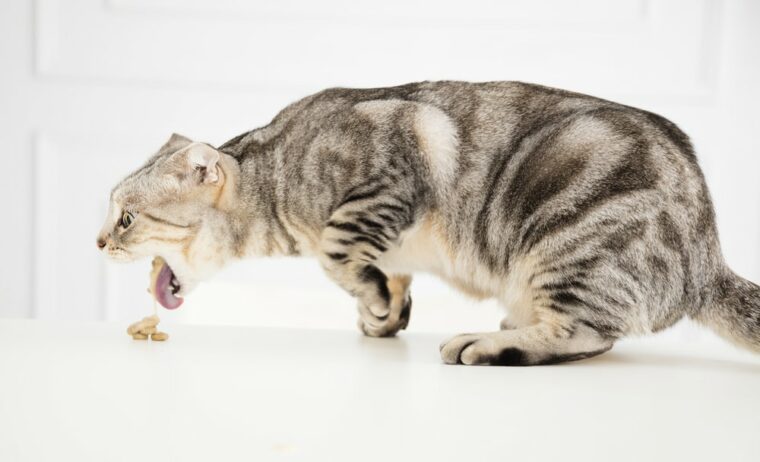
Cats are beloved family members, and it can be incredibly concerning when your companion isn’t feeling well. It’s particularly difficult to watch a cat struggle through the dry heaves. Dry heaving occurs when a cat repeatedly attempts to throw up, but nothing comes out.
It sometimes sounds like a cat is gagging or coughing, and cats often crouch and have stomach contractions at the same time. While it sometimes happens when cats eat too fast, dry heaving can also indicate that your cat has hairballs or has ingested a foreign body. Nausea is also seen in cats with kidney and liver conditions. If your cat dry heaves once or twice, there’s likely nothing to worry about. But if they suddenly start dry heaving repeatedly, reach out to your veterinarian right away for guidance, as the problem could be linked to a more concerning medical issue.
The 8 Reasons Why Your Cat Is Dry Heaving
1. Hairballs
Hairballs are bits of hair that collect in your cat’s digestive tract, which bunch together and can’t be pooped out. It’s a relatively common feline health issue and usually doesn’t require medical intervention if it only occurs once or twice. As cats groom themselves, they often swallow small amounts of fur, which can become hairballs over time. Hairballs, when brought up, often look like long thin tubes of fur, and they’re usually surrounded by clear, thin liquid.
Are There Ways to Minimize Hairballs?
Regular brushing helps since it reduces the amount of fur ingested while self-grooming. Increasing the amount of fiber in your cat’s diet often decreases the number of hairball incidents by making it easier for food (and fur) to pass through your pet’s digestive system. Also, several commercial products, including treats and hairball prevention cat food, provide fiber or act as mild laxatives.
2. Nausea
Sick cats often have gastrointestinal symptoms such as vomiting, diarrhea, and dry heaving. Tummy trouble can be caused by anything from eating something toxic to viral illness. Cats that eat plants often dry heave or throw up. However, cats can also develop upset stomachs if they have an infection or take a bite of food that’s gone bad.
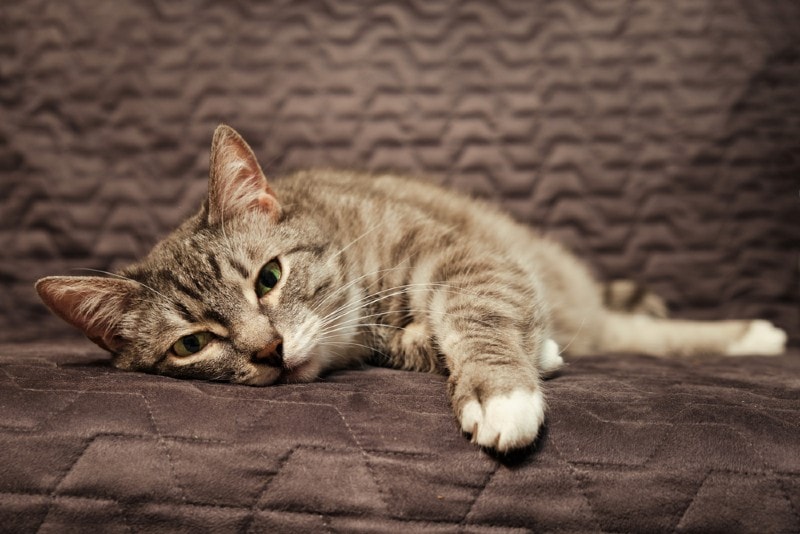
How Long Can Wet Food Be Left Out?
Wet food should be cleaned after mealtimes and not left out for hours for cats to graze on.
Where Can I Find More on Toxic Plants & Products?
The American Society for the Prevention of Cruelty to Animals (ASPCA) has information about toxic plants and foods.
3. Gastroenteritis
Gastroenteritis is the medical term for stomach and intestinal inflammation, and parasites, viruses and bacteria often cause it. Medications and new foods can also contribute to the condition. It’s typically accompanied by vomiting and diarrhea.
Cats with gastroenteritis sometimes have tender stomachs and resist being picked up. Others avoid eating, become lethargic, and hide. Dehydration is a common side effect of gastroenteritis and can be treated with oral, subcutaneous, or IV rehydration. Veterinarians use blood tests and information from pet parents to identify gastroenteritis in cats.
How Is Gastroenteritis Treated?
It depends on the underlying cause. Cats with parasitic infections are treated with anti-parasite medications to get better. Switching back to your cat’s old food often works if their new kibble is causing the problem. If medications are causing issues, veterinarians can find alternatives.
4. String Ingestion
Cats sometimes try (unsuccessfully) to throw up after ingesting things their digestive tracts can’t physically handle, which are often long, thin items such as string and twine.
Materials like cotton string can easily get caught in your cat’s stomach or intestines. Items like tinsel and ribbon can also snag on the sharp papillae of your cat’s tongue, preventing whatever is caught from moving through your cat’s body. Long thin items can also collect in your pet’s stomach or intestines, which often requires surgical intervention.
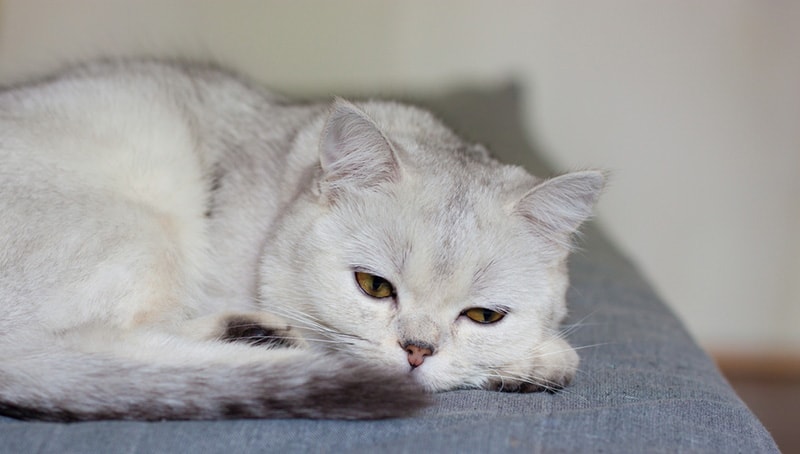
Why Is String Ingestion So Problematic?
String can become anchored at one end whilst the gastro-intestinal tract is still attempting to move it though. This can result in the intestines becoming bunched up, plicated, and damaged. If a blockage develops and the situation isn’t addressed quickly enough, conditions such as peritonitis and sepsis can develop. Peritonitis is a painful condition involving inflammation of the peritoneum, a membrane that holds abdominal blood vessels, organs, and nerve endings. Sepsis is a serious systemic infection that progresses to the point where a cat’s body begins to shut down.
5. Kidney Disease
Cats depend on their kidneys to remove waste and balance electrolytes, and they play a role in blood pressure regulation and water conservation. Cats suffering from kidney disease often suffer nausea as waste products build up in their systems. There are two general types of kidney disease: acute and chronic.
Acute kidney failure is often caused by ingesting toxic materials or chemicals or urinary tract blockage. Examples of chronic conditions that impact the kidneys include polycystic kidney disease and high blood pressure. Many chronic conditions lead to reduced kidney function over time, often ultimately resulting in organ failure.
Does Increased Hydration Help Cats With Kidney Disease?
Absolutely. Not only does sufficient water intake help cats with most types of kidney disease, but it’s also critical for your cat’s overall health and well-being. There are two simple ways to increase cats’ water intake. You can purchase a cat fountain to encourage your pet to drink more and serve wet food that contains at least 78% moisture.
6. Liver Disease
The liver is critical to proper metabolic functioning and detoxification. Liver disease can be acute or chronic. Acute liver injuries are often caused by toxin ingestion. Chronic conditions are often linked to inflammatory conditions. The liver can often recover from acute injuries with supportive care, but cats with chronic conditions often require long-term medication and often have a less optimistic prognosis.
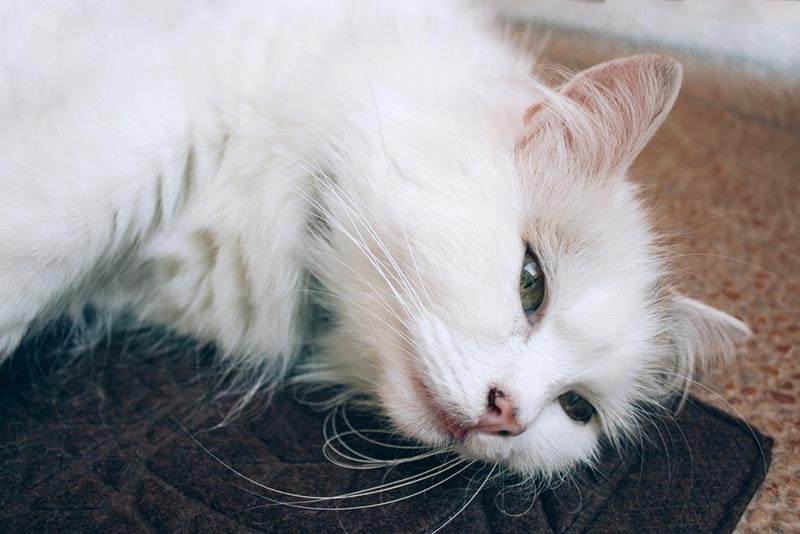
What Are the Signs of Liver Disease?
Gastrointestinal problems such as vomiting and diarrhea are frequently present in cats with liver disease. Increased thirst, urination, jaundice, and weight loss are also commonly seen. Liver issues are relatively common in older cats and can be identified through routine blood tests during your cat’s checkups.
7. Eating Too Fast
Cats sometimes get dry heaves when they’ve eaten too quickly. Many become enthusiastic when their favorite food makes an appearance, particularly if they’re not getting enough mental stimulation. Some cats that eat too quickly end up vomiting relatively soon after a few good heaves. Others settle down and don’t have any further problems.
Are There Ways to Slow Down Fast Feline Eaters?
Lick mats are simple to use and effective when it comes to slowing fast feline eaters. They’re essentially rubber or silicone mats with ridges and bobbles that hold wet food or kibble. Because cats must spend time licking their food free, it usually takes them a bit longer to get through mealtimes. Lick mats are also a great way to give your cat a bit of mental stimulation.
8. Asthma
Asthma is an immune reaction to inhaled particles that results in inflamed, irritated, and narrowed airways. It’s commonly accompanied by excess mucus production, which, combined with constricted airways, make it difficult for affected cats to breathe. Signs of the condition include difficulty breathing, coughing, wheezing, dry heaving, and sometimes throwing up.
Most cats are diagnosed when they’re between 4 and 5 years old. Veterinarians rely on blood tests and imaging studies such as X-rays and CT scans to determine if cats have asthma.
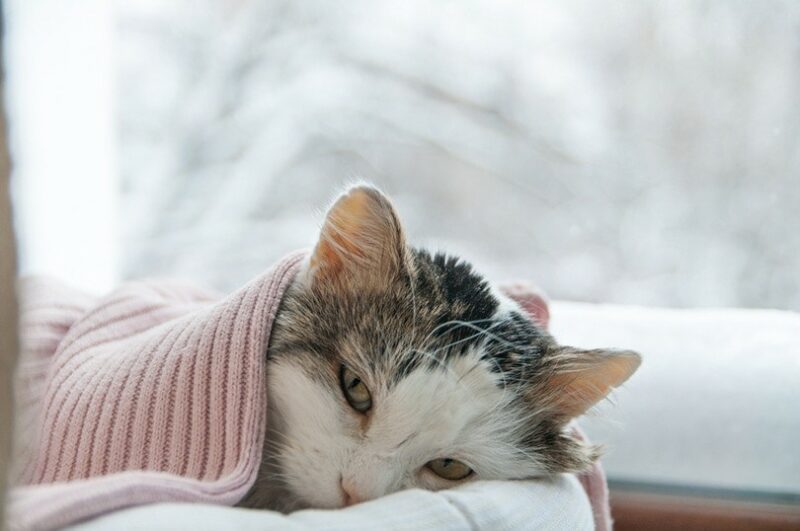
Can Feline Asthma Be Cured?
Asthma is a chronic problem that often worsens over time, but many cats do fine with medication and environmental management. Corticosteroids are often prescribed to soothe inflamed tissues, and bronchodilators to open constricted airways.
Final Thoughts
Cats can dry heave for a multitude of reasons, including hairballs, nausea, eating too fast and through to severe medical conditions like liver and kidney disease. Fortunately it’s usually nothing to worry about if it happens occasionally.
However, cats also dry heave after ingesting foreign objects, poisonous plants, and toxic foods. Contact your veterinarian immediately if you suspect your pet has swallowed a foreign object or something poisonous.
Cats with gastrointestinal problems such as recurrent vomiting, diarrhea, or dry heaves should be evaluated by a veterinarian since stomach issues can sometimes indicate severe medical conditions such as kidney and liver disease.
Featured Image Credit: Tom Wang, Shutterstock






